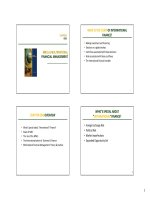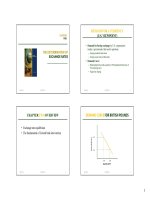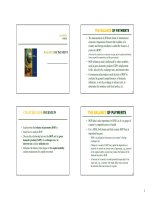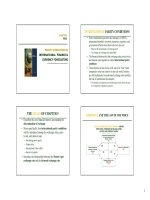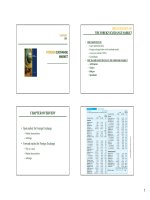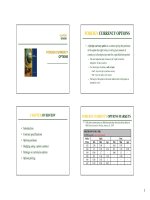Lecture multinational financial management chapter 3 ngo thi ngoc huyen
Bạn đang xem bản rút gọn của tài liệu. Xem và tải ngay bản đầy đủ của tài liệu tại đây (471.47 KB, 14 trang )
THE GOALS OF CHAPTER 3
MULTINATIONAL
FINANCIAL
MANAGEMENT
NGO THI NGOC HUYEN
• Introduce the history of the international monetary system,
from the gold-standard system, Bretton Woods
agreement, to modern international monetary systems
• Introduce the Eurocurrencies and their markets
• Compare different exchange rate regimes
• Introduce the capital mobility (the content in Ch 4)
• Analyze the exchange rate regimes for emerging markets:
currency boards and dollarization
• Introduce the history of the Euros
• Analyze the tradeoffs for international monetary systems
over the years
CHAPTER
THREE
THE INTERNATIONAL
MONETARY SYSTEM
HISTORY OF THE
INTERNATIONAL MONETARY
SYSTEM
1
HISTORY OF THE INTERNATIONAL
MONETARY SYSTEM
• The (classical) gold standard system (1876-1913)
– “Rules of the game” were simple: each country sets the rate at
which its currency could be converted to a weight of gold, or
said to set the par value for its currency in terms of gold
• For the U.S. and the U.K., $20.67 and £4.2474 can exchange
for an ounce of gold, so the dollar/pound exchange rate was
($20.67/ounce of gold) / (£4.2474 /ounce of gold) = $4.8665/£
– Since each government agreed to buy or sell gold with anyone
at its announced rate, so exchange rates between currencies
were in effect “fixed”
• Maintaining adequate reserves of gold to back its currency’s
value was very important for a country under this system
– The system implicitly limits the rate at which any individual
country could expand its monetary supply
• Any growth in the amount of money was limited to the rate at
which official authorities could acquire addition gold
HISTORY OF THE INTERNATIONAL
MONETARY SYSTEM
– The gold standard system can adjust the balance of
payments (BOP) by itself
• Surplus in BOP increase of reserves of gold government
increases monetary supply (expansionary monetary policy)
IR↓ (international capital outflows), price level↑ (decrease of
export and increase of import) decrease cash inflow to
reduce the surplus in BOP
• Deficit in BOP decrease of reserves of gold government
decreases monetary supply (contractionary monetary policy)
IR↑ (attract international capital), price level↓ (increase of
export and decrease of import) increase cash inflow to
decrease the deficit in BOP
※If all countries follow the above rule, it is impossible for a
country to have persistent surpluses or deficits for many years
– This classical gold standard system was in effect until the
outbreak of WWI, since the free movement of gold was
interrupted in the war
HISTORY OF THE INTERNATIONAL
MONETARY SYSTEM
• The Inter-War Years & WWII (1914-1944)
– During WWI, many countries issue more currencies to
support the war even without the increase of reserves of gold
– Therefore, currencies fluctuate over a fairly wide range in
terms of gold and each other
– After WWI, the U.K. tried to restore the gold standard system
and maintain the same exchange rate between its currency
and gold as that before WWI
– Since the reserves of gold did not increase for the U.K., but
the outstanding amount of pound is several times than that
before WWI, the pound is obviously overvalued at that rate
– International speculators sold short weak currencies to gain
profit, e.g., pound, which further reduced the reserves of gold
of these countries. The reverse happened with strong
currencies
HISTORY OF THE INTERNATIONAL
MONETARY SYSTEM
– Short selling means that the investor sells an asset he does
not own and later buy it back and delivery it to the buyer at a
future date
– For overvalued currency (weak currency) short sell
currency to the government for gold (with more weight)
if the currency really devalues buy the currency back at
the expense of gold (with less weight) and deliver the
currency to the government earn gold from the
government
– For undervalued currency (strong currency) buy currency
from the government at the expense of gold (with less
weight) if the currency really revalues sell the
currency back to the government and obtain gold (with more
weight) earn gold from the government
2
HISTORY OF THE INTERNATIONAL
MONETARY SYSTEM
– The countries with surplus in BOP, e.g., the U.S. and France,
adopted the sterilized intervene (by issuing government bonds
to offset the increased monetary supply caused by the surplus
in BOP) to maintain the surplus and accumulate gold
continuously
– Therefore, the gold standard system cannot adjust BOP any
more, which is one of the reasons for the crash of the gold
standard system
– In 1931, the U.K. ceased the conversion between the pound and
gold and left the gold standard system
– The U.S. adopted a modified gold standard in 1934, in which
the U.S. Treasury traded gold only with foreign central banks,
not with private citizens
– During WWII and its chaotic aftermath, the US$ was the only
trading currency that continued to be convertible
HISTORY OF THE INTERNATIONAL
MONETARY SYSTEM
• Bretton Woods and the International Monetary Fund
(IMF) (1944)
– As WWII drew to a close, the Allied Powers met at Bretton
Woods, New Hampshire to create a post-war international
monetary system
– The Bretton Woods Agreement established a U.S. dollarbased international monetary system and created two new
institutions, the International Monetary Fund (IMF) and the
World Bank
– The International Monetary Fund is a key institution in the
new international monetary system and was created to:
• Render temporary assistance to member countries defend their
currencies against cyclical, seasonal, or random occurrences,
e.g., financial crisis
HISTORY OF THE INTERNATIONAL
MONETARY SYSTEM
• Assist countries having structural BOP or exchange rate
problems if they promise to take adequate steps to correct these
problems
• Each member country of IMF should deposit some reserves at
the IMF, in which 25% is gold (special drawing right, SDR, and
75% is the local currency (general drawing right, GDR)
• Member countries can borrow the gold tranche freely, but need
to pay interests for the GDR
– Member countries may settle transactions among themselves by
transferring SDRs
– When a country uses the GDR to pay for the deficit of its BOP, it
uses the local currency to buy other currencies. After the there is a
surplus in BOP, the country buys back its local currency
– The International Bank for Reconstruction and Development
(World Bank) helped fund post-war reconstruction and since
then has supported general economic development
HISTORY OF THE INTERNATIONAL
MONETARY SYSTEM
• Under the Bretton Woods Agreement
– All countries fixed the value of their currencies in terms of gold
but were not required to exchange their currencies for gold
– Only the dollar remained convertible into gold (at $35 per
ounce) (at this time point, 75% of gold is held by the U.S.)
– Each currency established its exchange rate with the dollar
– Participating countries agreed to maintain the value of their
currencies within 1% of par by buying or selling foreign
exchange or gold as needed
– Devaluation was not to be used as a competitive trade policy
– If a currency became too weak to defend, a devaluation of up to
10% was allowed without formal approval by the IMF
– However, large devaluations required IMF approval
※This is known as the gold-exchange standard system
3
HISTORY OF THE INTERNATIONAL
MONETARY SYSTEM
• Fixed Exchange Rates (1945-1973)
– The currency arrangement negotiated at Bretton Woods and
monitored by the IMF worked fairly well during the postWWII era of reconstruction and growth in world trade
– However, widely diverging monetary and fiscal policies,
differential rates of inflation, and various currency shocks
resulted in the system’s demise
– In fact, among 21 industrialized countries, currencies of 12
(4) countries revalue (devalue) relative to US$
– The U.S. had consistent deficits in BOP in this period, that
generates the outflow of the US$ to other countries
HISTORY OF THE INTERNATIONAL
MONETARY SYSTEM
– By the late February 1973, the fixed-rate system no longer
appeared feasible given the speculative flows of currencies
– The major foreign exchange markets were actually closed
for several weeks in March 1973, and when they reopened,
most currencies were allowed to float to levels determined
by market forces
– In June 1973, floating rates continued to drive the now
freely floating US$ down by about 10%
• These outflows were partially due to the growing demand for
dollars from investors, businesses, and central banks of other
countries, because the US$ is the most important foreign
reserve currency in that period
• The U.S. did not adopt the contractionary monetary policy
HISTORY OF THE INTERNATIONAL
MONETARY SYSTEM
– Eventually, the large amount of dollars held by foreigners
resulted in a lack of confidence in the ability of the U.S. to
meet its commitment to convert dollars to gold
– In 1962, France asked the U.S. to pay off its debt in gold
– In 1968, the U.S. held only 25% of the gold of the world
– The lack of confidence forced President Richard Nixon to
suspend official purchases or sales of gold by the U.S.
Treasury on August 15, 1971 (the international monetary
system is from gold-exchange standard to dollar standard in
nature)
– This resulted in subsequent devaluations of the dollar, so in
Smithsonian Agreement in Dec. 1971, ten countries agreed
that the US$ is devalued to $38/oz. of gold
HISTORY OF THE INTERNATIONAL
MONETARY SYSTEM
• An Eclectic Currency Arrangement (1973-Present)
– Since March 1973, exchange rates have become much more
volatile than they were during the “fixed” period
– Jamaica Agreement:
• In Jan. 1976, IMF meeting in Jamaica resulted in the
“legalization” of the floating exchange rate system already in
effect, and gold was demonetized as a reserve asset
• Member countries can choose among different exchange rate
regimes freely (the classifications of IMF’s exchange rate
regime are introduced later)
• The special drawing right is no longer defined in terms of gold.
The SDR is redefined every 5 years. Today, SDR is the
weighted average of four major currencies: 44% US$, 34%
Euro, 11% Japanese yen, and 11% British pound
• The SDR still serves as a unit of account for the IMF, so
members can settle transactions among themselves by
transferring SDRs
4
HISTORY OF THE INTERNATIONAL
MONETARY SYSTEM
• Each country’s foreign exchange reserves includes 1) SDR
in the form of deposits at the IMF; 2) its reserve position
at the IMF; 3) foreign exchange; 4) the official holdings of
gold
※Foreign exchange: the foreign asset of a country,
including the holdings of foreign currencies, securities,
notes, and deposits by the government and private citizens
(even these assets are deposited in foreign banks)
※Since Taiwan is not the member of the IMF, the foreign
exchange reserves of Taiwan means foreign exchange and
the official holdings of gold
INTRODUCTION OF EUROCURRENCIES
AND THEIR MARKETS
• Eurocurrencies
– These are domestic currencies of one country on deposit in a
second country
– Thus, “Euro” means offshore rather than European zone
– In addition to Eurodollars, there are also Eurosterling,
Euroyen, etc.
– The Eurocurrency markets serve two valuable purposes for
international corporations or corporations conducting
international trade:
• Eurocurrency deposits are an efficient and convenient money
market device for allocating excess corporate liquidity
• The Eurocurrency market is a major source of short-term bank
loans to finance corporate working capital (investment in
inventory and accounts receivable) needs, including export and
import financing
INTRODUCTION OF EUROCURRENCIES
AND THEIR MARKETS
– The history of the modern Eurodollar market
EUROCURRENCIES AND
THEIR MARKETS
• During 1950s, investors or banks in communist countries, like
Soviet Union and Eastern European countries, deposit their
dollar holdings in Western European banks because they are
afraid the deposits might be attached by the U.S. with claims
against communist governments
• In 1957, in order to improve the BOP, British imposed tight
controls on U.K. banks lending sterling to non-UK investors
or businesses. U.K. banks turned to conduct dollar lending
business in order to maintain their leading position in world
finance
• After WWII, due to the large financial help from the U.S. to
other countries and the surplus of BOP for European countries
against the U.S., the amount of Eurodollars rises significantly
• During 1970s, with the rise of the oil price, oil output
countries obtained large amount of US$ and deposited in the
Eurodollar market
5
INTRODUCTION OF EUROCURRENCIES
AND THEIR MARKETS
– Eurocurrency Interest Rates: LIBOR and LIBID
• In the Eurocurrency market, the reference rate of interest is the
London Interbank Offered Rate (LIBOR) and London
Interbank Bid Rate (LIBID)
• For example, Eurodollar LIBOR (LIBID) is the mean of 16
multinational banks’ interbank offered (bid) rates for
Eurodollars sampled by the British Bankers Association (BBA)
at 11 a.m. London time in London
DIFFERENT EXCHANGE
RATE REGIMES
– The bid rate is a rate at which a bank needs to pay for borrowing
money or accepting deposits
– The offer (or ask) rate is a rate at which a bank can earn for
lending money
– The bid-ask spread is one source of profit for banks
※BBA also collects the data of bid and ask rates for other
Eurocurrencies
3-23
INTRODUCTION OF EUROCURRENCIES
AND THEIR MARKETS
• The bid-ask spread for Eurodollars is smaller than the bid-ask spread
for dollars
– The Eurodollar LIBOR is generally smaller than the loan rates in the
U.S. because the Eurodollar market is a wholesale market
– The Eurodollar LIBID is generally higher than the deposit rates in the
U.S. because foreign banks are not subject to the U.S. regulations of the
reserves requirements and deposit insurance fees
» The Fed in the U.S. asks a minimum percentage of reserves requirement
for the deposits of banks
» The deposit insurance is to against the liquidity risk for “run on the bank”
problems, in which many depositors lose confidence in banks and want to
withdraw money simultaneously
» Without the cost to prepare reserves requirements and deposit insurance,
foreign banks can provide a higher interest rate to borrow US$ or to accept
US$ deposits
– The narrower offer-bid spread is also an important reason for the
booming development of the Eurodollar market
THE IMF’S EXCHANGE RATE
REGIME CLASSIFICATIONS
• The IMF classifies all exchange rate regimes into eight
specific categories spanning the spectrum from rigidly
fixed to independently floating
– Exchange arrangements with no separate legal tender
(Ecuador, Panama, EU)
• Using the currency of other country as the legal tender (Ecuador,
Panama, etc.)
• Sharing the same legal tender in a monetary union (EU)
– Currency board arrangements (HK)
• Maintaining the fixed exchange rate between the domestic
currency and a specified foreign currency by legislation
• In addition, issuing more domestic currencies only when
acquiring the specified foreign currency
• HK maintains about 7.8 HK dollars/US$ since 1983
6
THE IMF’S EXCHANGE RATE
REGIME CLASSIFICATIONS
– Other conventional fixed peg arrangements (China)
• The country pegs its currency at a fixed rate to a major currency or a
basket of currencies
• In addition, the exchange rate fluctuates within 1% around the
central rate
– Pegged exchange rates within horizontal bands (Denmark,
Hungary)
• Similar to the conventional fixed peg arrangements, but the margin
of fluctuation is wider than ±1%
– Crawling pegs (Nicaragua, Costa Rica)
• The country pegs its currency at a fixed, preannounced rate to a
major currency or a basket of currencies within a small fluctuation
range (usually smaller than 1%)
• The exchange rate is adjusted periodically or in response to changes
in selective quantitative indicators (e.g., the inflation rates in the
local country and in the major trading partners)
FIXED VERSUS FLEXIBLE
EXCHANGE RATES
• A nation’s choice as to which currency regime to
follow reflects national priorities about all facets of
the economy, including inflation, unemployment,
interest rate levels, trade balances, and economic
growth
• The choice among different exchange rate regimes
may change over time as priorities change
• Next I will compare the advantages and
disadvantages for the fixed and float exchange rate
regimes
THE IMF’S EXCHANGE RATE
REGIME CLASSIFICATIONS
– Exchange rates within crawling pegs
• Similar to the crawling pegs, but the margin of fluctuation is
wider than ±1%
– Managed floating with no pre-announced path (Taiwan)
• The monetary authority attempts to influence the exchange rate
without specifying or pre-announcing exchange rate target
• Indicators for managing the rate includes the balance of payments
position, foreign reserves, parallel market developments, etc.
• It is also called the dirty float
– Independent floating (U.S., Japan, Australia)
• The exchange rate is market-determined, with any official foreign
exchange market intervention aimed at moderating the rate of
change and preventing undue fluctuations in the exchange rate,
rather than at establishing a level for it
FIXED VERSUS FLEXIBLE
EXCHANGE RATES
• Fixed rate regime
– Advantages:
• Provide stability in international prices, which helps the growth of
international trade and reduces risks for all businesses
• Fixed exchange rates are inherently anti-inflationary as long as the
country follows the policy to increase the monetary supply only
when acquiring additional foreign exchange reserves
– Problems:
• The restrictiveness is a burden for a country to pursue policies to
alleviate internal economic problems, such as high unemployment
or slow economic growth
• Need for central banks to maintain large quantities of hard
currencies and gold to defend the fixed rate
• Fixed rates could be maintained at rates that are inconsistent with
economic fundamentals
• The fixed rates must be changed administratively or by legislation,
usually with late response and at a too large a one-time cost
7
FIXED VERSUS FLEXIBLE
EXCHANGE RATES
EXCHANGE RATE VOLATILITY UNDER
DIFFERENT EXCHANGE RATE REGIMES
• Float exchange rate regime
– Advantages
• The change of the exchange rate can adjust the balance of
payments automatically
• Central banks can maintain the independency about the
monetary policy, i.e., the associated decisions are
independent about foreign currencies
• It is not necessary for central banks to maintain large
quantities of foreign exchange reserves
– The reduction of foreign exchange reserves can be used to help
the economic development of the country
FIXED VERSUS FLEXIBLE
EXCHANGE RATES
– Disadvantages
• The fluctuation of the exchange rate may impede the
international trade and investment
• Central banks abuse the monetary independency to issue too
many currencies, which may result in serious inflation
• All nations incline to adopt the expansionary monetary policy
and the depreciation policy
– An expansionary monetary policy can stimulate the economic
growth
– A depreciation policy can maintain the competitive ability of export
※If all nations adopt these strategies, the international economy and
monetary system will be in disorder
• The foreign impact could affect the economic operation of the
local country through the exchange rate
※ At first glance, it is surprised that currencies that are pegged had higher volatilities
than those within limited flexibility regimes. Please note that the declaration of a peg
does not necessarily mean that the currency’s value never changed
※ Not surprisingly, the freely floating regime currency volatilities were the highest
※ The freely falling classification is for those specific countries that suffered severe
crisis (usually these countries adopt the pegged or managed floating regime)
※ Volatilities in the 1991-2001 period is not higher than those in other periods,
although there were many exchange rate crises in the 1990s (Mexico in 1994, Asia
in 1997, Russia in 1998, Brazil in 1999)
※ Possible reasons: 1) the US$ problem in 1981-1985; 2) the weighted average method
ATTRIBUTES OF THE “IDEAL”
CURRENCY
• Possesses three attributes, often referred to as the
Impossible Trinity:
– Exchange rate stability
• As the exchange rate is more stable, the investors and businesses
suffer less exchange rate risk
– Full financial integration
• Complete freedom of moving funds from one country and
currency to another in response to possible economic
opportunities or risks
– Monetary independence
• Domestic monetary and interest rate policies can be set by
individual country to pursue policies to limit inflation, combat
recession, and enhance employment
※The forces of economics can not allow the simultaneous
achievement of all three. A country must give up one of the
above three goals
8
Attributes of the “Ideal” Currency
Malaysia 1998-2002
CAPITAL MOVEMENTS
• The degree to which capital moves freely across
borders is critically important to a country’s balance of
payments
• The high capital mobility sometimes can help a
country, but sometimes will hurt a country
US
EU
•
In 1998-2002, Malaysia maintained very tight controls over the capital flow, so
it retained it monetary independence and a stable exchange rate, but lack the
integration with global financial and capital market
•
The force of the need of increased capital mobility pushes more countries
toward full financial integration such that their business can attract international
capital and their domestic economy can be stimulated
•
Therefore, these countries are forced to adopt either purely floating (like the
U.S.) or integrated with other countries in monetary unions (like the EU)
– The financial account surplus has probably been one of the
major reasons that the U.S. dollar has been able to maintain
its value over the past 20 years
– Other countries, e.g., Brazil in 1998-1999 and Argentina in
2001-2002, have experienced massive financial account
outflows, which were major components of their economic
and financial crisis
CAPITAL MOVEMENTS
Some researchers argue that the post-1860 era can be
divided into four distinct periods with regard to capital
mobility
CAPITAL MOBILITY
1860-1914: continuously increasing capital mobility as the gold
standard system was adopted and international trade relations
were expanded (gold standard system)
1914-1945: global economy was destructed, many isolationist
economic policies, negative effect on capital movement
between countries (WWI-WWII)
1945-1971: Bretton Woods era causes a great expansion of
international trade, but only the slow and steady recovery of
capital markets (Bretton Woods Agreement)
1971-2002: due to floating exchange rates and economic
volatility, cross-border capital flows expand rapidly (Eclectic
Currency Arrangement)
9
EXHIBIT 1 A STYLIZED VIEW OF CAPITAL
MOBILITY IN MODERN HISTORY
EXCHANGE RATE REGIMES FOR
EMERGING MARKETS
CAPITAL MOVEMENTS
• Capital can be moved via international bank transfers (legal),
with physical currency, collectables or precious metals,
money laundering (the cross-border purchase of assets in a
way that hides the movement of money and its ownership),
or false invoicing of international trade transactions
(underinvoicing or overinvoicing of imports and exports,
where the difference is another kind of capital movement)
• Although no single accepted definition of capital flight
exists, it can be characterized as serious capital movement
occurring when residents lose confidence in the government
due to political or financial problems
EMERGING MARKETS
AND REGIME CHOICES
• During 1997-2005, the increased mobility pressures
push emerging market countries to choose among
more extreme types of exchange rate regimes
Many heavily indebted countries have suffered capital flight,
deteriorating their debt service problems
10
EMERGING MARKETS
AND REGIME CHOICES
• A currency board exists when a country’s central
bank commits to back its monetary base–its monetary
supply–entirely with foreign reserves at all times
• This means that a unit of domestic currency cannot be
introduced into the economy without an additional
unit of foreign exchange reserves being obtained first
– Argentina moved from a managed exchange rate system to a
currency board regime in 1991
• The currency board structure fixed the Argentine peso’s value
to the US$ on a one-to-one basis
• Only after Argentina had earned these dollars through trade, its
money supply could be expanded
EMERGING MARKETS
AND REGIME CHOICES
• The advantage of this requirement eliminated the possible of the
nation’s money supply growing too rapidly and causing inflation
• There was substantial doubt in the market that the Argentine
government could maintain the fixed exchange rate
• One explicit signal is that the Argentine banks paid slightly higher
interest rates on peso-denominated accounts than on dollardenominated accounts, which reflects the risk for investors to
keep their money in peso
– After three years of economic recession and months of
economic and political chaos, in 2002, Argentina ended the
currency board exchange rate system
– The Argentine crisis is presented in detail in Ch 10
EMERGING MARKETS
AND REGIME CHOICES
• Dollarization is the use of the US dollar as the official
currency of the country
• One attraction of dollarization is that sound monetary
and exchange-rate policies no longer depend on the
intelligence and discipline of domestic policymakers
– Panama has used the U.S. dollar as its official currency since
1907
– Ecuador case:
• During 1999, Ecuador suffered a rising inflation rate and a “run
on the bank” crisis, i.e., a series of unexpected withdrawals
caused by a sudden decline in depositors’ confidence or fear
that the bank will close
• Ecuador replaced its domestic currency with the US dollar in
September 2000 and became the largest dollarization nation
• Solved the “run on the bank” crisis immediately and controlled
the inflation rate after 3 years
EMERGING MARKETS
AND REGIME CHOICES
• Advantages for dollarization
– Removes any currency volatility against the U.S. dollar
– Eliminate the possibility of future currency crises if there is
no problem for the U.S. dollar
– Provide greater economic integration with the U.S. and other
dollar-based markets, both in product and finance
• Disadvantages for dollarization
– Lose independency over monetary polices, which obtains a
byproduct to share similar inflation rates in the U.S.
• Ironically, this byproduct is a desired feature for many countries to
adopt the dollarization regime
– Lose the power of seigniorage (鑄幣權)
– Due to the inability to create money, the central bank cannot
serve the role of the lender of last resort to save financial
institutions during financial crisis
11
THE EURO:
BIRTH OF A EUROPEAN CURRENCY
HISTORY OF THE EUROS
THE EURO:
BIRTH OF A EUROPEAN CURRENCY
• The pioneer of the Euro is from the European
Monetary System (EMS) in 1979
• The original 15 members of the European Union (EU)
are also members of the EMS
• The members in EMS tried to maintain stable
exchange rates among themselves because they rely
heavily on trade with each other and realize the
benefits of fixed exchange rates among themselves are
great
• The different goals in different countries caused the
failure of this system
• The disorder in EMS generates the demand for a
common currency
• In December 1991, the members of the European
Union met in Maastricht, Netherlands to finalize a
treaty that changed Europe’s currency future
• This treaty set out a timetable and a plan to replace
all individual currencies with a single currency
called the Euro, that leads to a full European
Economic and Monetary Union (EMU)
THE EURO:
BIRTH OF A EUROPEAN CURRENCY
• To prepare for the EMU, a strong central bank, called
the European Central Bank (ECB), was established in
Frankfurt, Germany
– The ECB is responsible for financial market intervention and
the issuance of the euro, and the corresponding goals for each
action are to stabilize the euro and prevent the inflation
undermining the purchasing power of the euro, respectively
– The ECB is free of political pressures for stimulating
economies that have historically bothered monetary
authorities
– For example, Germany adopted the contractionary policy to
stabilize the inflation, but France adopted the expansionary
monetary policy to alleviate the unemployment problem
12
THE EURO:
BIRTH OF A EUROPEAN CURRENCY
• The following convergence criteria are needed to meet
before each member country in the EU becomes a full
member of the EMU
– Nominal inflation should be no more than 1.5% above the
average for the three members of the EU with the lowest inflation
rates during the previous year (a high degree of price stability)
– Long-term interest rates should be no more than 2% above the
average for the three members with the lowest interest rates
(convergence in long-term interest rates)
(The above two criteria help to stabilize the exchange rate)
– Fiscal deficits should be no more than 3% of gross domestic
product (GDP)
– Government debt should be no more than 60% of GDP
(The above two criteria ensure sustainable government finance)
※The criteria were so tough that only 11 countries managed to do
so before the launch of the Euro in 1999
Effects of the Euro
– It help to create deeper capital markets and make bigger
deals possible
– The Euro is becoming a popular reserve currency,
representing 19.7% of central banks’ holding in Feb. 2004
– Strong euro deadly for exporter who face competition from
China and Japan
• After three-year decline of the euro, the euro started to appreciate
from 2001 to 2008
– Enhance the probability that a financial crisis in one nation
will infect whole zone
• The problems for Greece and Spain starting from 2009 could hurt the
whole EMU
– The unified monetary policy causes a limit for slow-growth
countries because they cannot solve their domestic economic
problems by monetary policies
Effects of the Euro
• The Euro affects markets in following ways:
– EMU (16 member countries now) is a single-currency area
within the EU (27 member countries now), now known as the
euro zone
– The euro zone is integrated as one market for both consumers
and companies since the launch of the euro
– Cheaper transaction costs in the euro zone, e.g., Philips saves
0.3 billion US$ currency transaction cost per year
– Currency risks and costs related to exchange rate uncertainty
are reduced
– All consumers and businesses both inside and outside the euro
zone enjoy price transparency and increased price-based
competition
TRADEOFFS FOR
INTERNATIONAL MONETARY
SYSTEMS OVER THE YEARS
13
INTERNATIONAL MONETARY SYSTEM:
THE PAST AND THE FUTURE
• All international monetary systems must deal with the
tradeoff between rules and discretion (vertical), as well as
between cooperation and independence (horizontal)
Governments intervene little
Governments act
on their own
INTERNATIONAL MONETARY SYSTEM:
THE PAST AND THE FUTURE
– In 1985, ten countries met at the Plaza Hotel in NY to sign
an international cooperative agreement to control the
volatility of world currency markets
• Many believe that a new international monetary
system could succeed only if it combined
cooperation among nations with individual
discretion to pursue domestic social, economic, and
financial goals
Governments consult
and act in unison with
other countries
Governments intervene
the market discretionarily
INTERNATIONAL MONETARY SYSTEM:
THE PAST AND THE FUTURE
• The pre WWII Gold Standard required adherence to
rules and allowed independence
• The Bretton Woods agreement also required adherence
to rules, and countries were required to cooperate to
maintain the dollar-based system
• The EMS from 1979 to 1999 is a hybrids of these
cooperative and rule regimes
• U.S. dollars for 1981 to 1985
– The U.S. dollar was the most important currency in that time
period
– From 1981 to 1985, the U.S. concentrated on solving its
domestic economic problems, that causes the exchange rates
to be become too volatile
14

